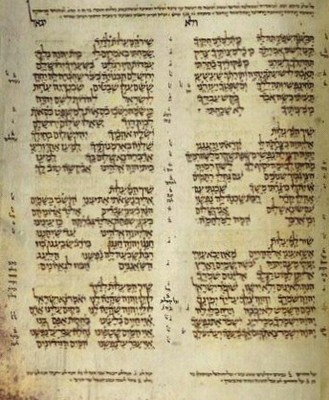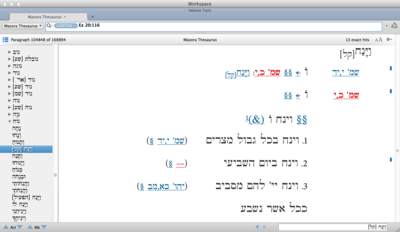Finally, the Masorah of the Hebrew Bible is available in digital format, searchable on your computer (both Windows and Macintosh). For centuries, the textual information compiled by the ancient scribes (Masoretes) of the Hebrew Bible was the private domain of scholars who specialized in masoretic studies. But now, thanks to Prof. Aron Dotan (arguably the leading Masoretic scholar of our times) and Accordance Bible Software, all of this important textual information is instantly available to anyone with just a few keystrokes on your computer.
Some might ask, “What exactly is the Masorah?” The Masorah (or Masora) consists of the notes compiled by the Masoretes (the scribes who wrote the codices of the Hebrew Bible from the 6th Century CE onward) written in the margins between the columns of the biblical text1, at the top and bottom of the page2 and on the final pages of the codex3. The primary purpose of the notes was to ensure accuracy as the biblical text was copied. They therefore point out textual anomalies: peculiar spellings, where full and defective spellings occur, as well as qere/ketiv (where an alternative reading is traditional as over against what is written in the text itself) and other textual issues. The Masorah is therefore an extremely valuable resource for textual criticism of the Hebrew Bible.
The Masora Thesaurus Module, unveiled by Accordance Bible Software at the 2013 ETS & SBL Annual Meetings in Baltimore, is the culmination of many years of meticulous work by Aron Dotan and Nurit Reich. The Thesaurus he has compiled (now a module for Accordance) lists every Hebrew word marked with a masoretic note in the Leningradensis Codex. Each of these words is listed alphabetically in the Thesaurus with accompanying data relative to each form or entry. Does the Masora indicate that the exact form of a given word is found elsewhere? Then you’ll find these references listed, hyper-linked (for viewing in the instant details) and fully cross-referenced. Are there variations between the Masoretic lists of Leningradensis and the Aleppo Codex? Then many of these will be noted as well. Are you studying a particular verse in the Hebrew Bible and want to check if there are masoretic notes on that verse? Just search that Scripture reference and all of the information will be instantly displayed. Additionally, any other masoretic note that cross-references the text you’re studying comes up in the search. What before would have been almost impossible to find is now readily displayed in seconds.
But there is even more! Information from other important masoretic studies has also been noted where applicable. For instance, say you’re researching a given masorah entry or Scriptural reference and you wonder if there is pertinent information to be found in Christian Ginsburg’s massive four volume The Masorah (1880–1905)? That’s right: Dotan has noted many cross-references to Ginsburg’s work, giving you volume and page number to easily locate the entry. Finally, Ginsburg’s magisterial work has become a useable resource for everyone doing text critical studies in the Hebrew Bible. Add to this that the masoretic notes included in BHK, BHS, and the fascicles of BHQ are also compared in Dotan’s compilations and you have at your fingertips the ability to bring together information from the most relevant resources in masoretic studies. Finally, the ancient Masorah has become a useable tool for everyone.
[The Masora Thesaurus module requires the ability to read and use Hebrew.]
See also a user’s blog post.
1. Masorah Parva [Masora Qetanah], מסורה קטנה
2. Masorah Magna [Masora Gedolah], מסורה גדולה
3. Masorah Finalis [Masora Ma’arechet], מסורה מערכת



